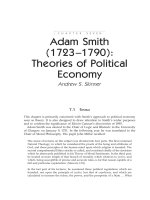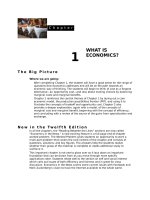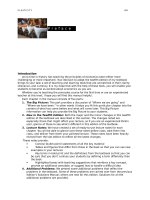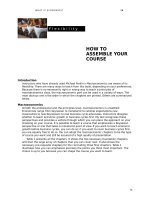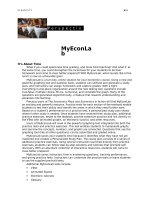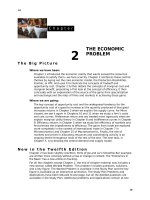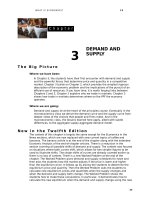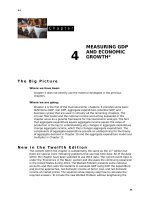Answers to review quizzes marcroeconomics 12e parkin chapter 7
Bạn đang xem bản rút gọn của tài liệu. Xem và tải ngay bản đầy đủ của tài liệu tại đây (383.82 KB, 12 trang )
W H AT I S E C O N O M I C S ?
119
C h a p t e r
7
FINANCE, SAVING,
AND
INVESTMENT**
Answers to the Review Quizzes
Page 202 (page 610 in Economics)
1.
Distinguish between physical capital and financial capital and give two
examples of each.
Physical capital is the actual tools, instruments, machines, buildings and other
items that have been produced in the past and are presently used to produce
goods and services. Financial capital is the funds that businesses use to acquire
their physical capital. Examples of physical capital are the pizza ovens owned by
Pizza Hut and the buildings in which the Pizza Huts are located. Examples of
financial capital are the bonds issued by Pizza Hut to buy pizza ovens and the
loans Pizza Hut has made to fund their purchases of new buildings.
2.
What is the distinction between gross investment and net investment?
Gross investment is the total amount spent on new capital; net investment is the
change in the value of the capital stock. Net investment equals gross investment
minus depreciation.
3.
What are the three main types of markets for financial capital?
The main types of markets for financial capital are the loan markets, the bond
markets, and the stock markets.
4.
Explain the connection between the price of a financial asset and its interest
rate.
There is an inverse relationship between the price of a financial asset and its
interest rate. When the price of a financial asset rises, its interest rate falls.
Similarly, when the interest rate on an asset falls, the price of the asset rises.
Page 209 (page 617 in Economics)
1.
What is the loanable funds market?
The loanable funds market is the market in which households, firms, governments,
banks, and other financial institutions borrow and lend. It is the aggregate of all
the individual financial markets and includes loan markets, bond markets, and
stock markets. The real interest rate is determined in this market.
2.
Explain why the real interest rate is the opportunity cost of loanable funds.
119
120
The real interest rate is the opportunity cost of loanable funds because the real
interest rate measures what is forgone by using the funds. If the funds are loaned,
then the real interest rate is received. If the funds are borrowed, then the real
interest is paid for the funds. The real interest rate forgone when funds are used
either to buy consumption goods and services or to invest in new capital goods is
the opportunity cost of not saving or not lending those funds.
3.
How do firms make investment decisions?
To determine the quantity of investment, firms compare the expected profit rate
from an investment to the real interest rate. The expected profit from an
investment is the benefit from the investment. The real interest rate is the
opportunity cost of investment. If the expected profit from an investment exceeds
the cost of the real interest rate, then firms make the investment. If the expected
profit from an investment is less than the cost of the real interest rate, then firms
do not make the investment.
4.
What determines the demand for loanable funds and what makes it change?
The demand for loanable funds depends on the real interest rate and expected
profit. If the real interest rate falls and nothing else changes, the quantity of
loanable funds demanded increases. Conversely, if the real interest rate rises and
everything else remains the same, the quantity of loanable funds demanded
decreases. Movements along the loanable funds demand curve illustrate these
events. If the expected profit increases and nothing else changes, the demand for
loanable funds increases and the demand for loanable funds curve shifts
rightward. If the expected profit decreases and everything else remains the same,
the demand for loanable funds decreases and the demand for loanable funds
curve shifts leftward.
5.
How do households make saving decisions?
A household’s saving depends on five factors: the real interest rate, the
household’s disposable income, the household’s expected future income, wealth,
and default risk. A household increases its saving if the real interest rate increases,
its disposable income increases, its expected future income decreases, its wealth
decreases, or if default risk decreases.
6.
What determines the supply of loanable funds and what makes it change?
The supply of loanable funds depends on the real interest rate, disposable income,
expected future income, wealth, and default risk. An increase in the real interest
rate increases the quantity of loanable funds supplied; a decrease in the real
interest rate decreases the quantity of loanable funds supplied. An increase in
disposable income increases the supply of loanable funds; a decrease in
disposable income decreases the supply of loanable funds. An increase in wealth
decreases the supply of loanable funds; a decrease in wealth increases the supply
of loanable funds. An increase in expected future income decreases the supply of
loanable funds; a decrease in expected future income increases the supply of
loanable funds. Finally, an increase in default risk decreases the supply of loanable
funds; a decrease in default risk increases the supply of loanable funds.
7.
How do changes in the demand for and supply of loanable funds change the
real interest rate and quantity of loanable funds?
The real interest rate is determined by the supply of loanable funds and the
demand for loanable funds. The equilibrium real interest rate is the real interest
rate at which the quantity of loanable funds supplied equals the quantity of
loanable funds demanded. Changes in the demand for or supply of loanable funds
change the equilibrium real interest rate and equilibrium quantity of loanable
funds. If the demand for loanable funds increases and the supply does not change,
the real interest rate rises and the quantity of loanable funds increases. If the
120
W H AT I S E C O N O M I C S ?
121
demand for loanable funds decreases and the supply does not change, the real
interest rate falls and the quantity of loanable funds decreases. If the supply of
loanable funds increases and the demand does not change, the real interest rate
falls and the quantity of loanable funds increases. If the supply of loanable funds
decreases and the demand does not change, the real interest rate rises and the
quantity of loanable funds decreases.
Page 211 (page 619 in Economics)
1.
How does a government budget surplus or deficit influence the loanable
funds market?
A government budget surplus adds to the supply of loanable funds. A government
budget deficit adds to the demand for loanable funds.
2.
What is the crowding-out effect and how does it work?
The crowding-out effect refers to the decrease in investment that occurs when the
government budget deficit increases. An increase in the government budget deficit
increases the demand for loanable funds. As a result the real interest rate rises.
The rise in the real interest rate decreases—“crowds out”—investment.
3.
What is the Ricardo-Barro effect and how does it modify the crowding-out
effect?
The Ricardo-Barro effect points out that the crowding out effect is less than
predicted by looking only at the effect of a budget deficit on the demand for
loanable funds. The Ricardo-Barro effect asserts that as a result of a government
budget deficit households increase their saving to pay the higher taxes that will be
needed in the future to repay the debt issued to fund the deficit. The increase in
saving increases the supply of loanable funds. This increase in the supply of
loanable funds offsets the rise in the real interest rate from the increase in the
demand for loanable funds caused by the budget deficit. Because the real interest
rate does not rise as much, the decrease in investment, that is the amount of
crowding out, is less in the presence of the Ricardo-Barro effect.
121
Answers to the Study Plan Problems and
Applications
Use the following data to work Problems 1 and 2.
Michael is an Internet service provider. On December 31, 2014, he bought an
existing business with servers and a building worth $400,000. During 2015, his
business grew and he bought new servers for $500,000. The market value of some
of his older servers fell by $100,000.
1.
What was Michael’s gross investment, depreciation, and net investment
during 2015?
Michael’s gross investment was $500,000, his depreciation was $100,000, and his
net investment was $400,000.
2.
What is the value of Michael’s capital at the end of 2015?
Michael’s capital at the end of 2015 is equal to his capital at the beginning of
2015, $400,000, plus his net investment during the year, also $400,000, for a total
of $800,000.
3.
Lori is a student who teaches golf on Saturdays. In a year, she earns $20,000
after paying her taxes. At the beginning of 2014, Lori owned $1,000 worth of
books, DVDs, and golf clubs and she had $5,000 in a savings account at the
bank. During 2014, the interest on her savings account was $300 and she
spent a total of $15,300 on consumption goods and services. There was no
change in the market values of her books, DVDs, and golf clubs.
a. How much did Lori save in 2014?
Lori’s saving equals her disposable income minus her consumption expenditure.
Lori’s disposable income is $20,000 plus the interest on her savings account, $300,
for a total of $20,300.Her consumption expenditure is $15,300, so her saving is
$5,000.
b. What was her wealth at the end of 2014?
Lori’s wealth at the end of 2014 is equal to the value of her wealth at the
beginning of 2014 plus her saving during the year. At the beginning of 2014 Lori’s
wealth is $6,000—the value of her books, DVDs, golf clubs, and savings account.
Lori saved $5,000 during 2014 so her wealth at the end of the year is $11,000.
4.
Treasury Yields Fall to Two-Week Low
Treasury bond prices rose on Monday, pushing interest rates down. The
interest rate on 10-year bonds fell 4 basis points to 1.65%.
Source: The Wall Street Journal, August 27, 2012
What is the relationship between the price of a treasury bond and its interest
rate? Why does the interest rate move inversely to price?
When the price of a treasury bond rises, its interest rate falls. This inverse
relationship exists because of the definition of an interest rate. The interest rate
equals the amount paid as interest divided by the price of the security, then
multiplied by 100. When the price rises, mathematically the interest rate must fall.
F I N A N C E , S AV I N G , A N D I N V E S T M E N T
Use the following information to work Problems 5 and 6.
First Call, Inc., a smartphone company, plans
to build an assembly plant that costs $10
million if the real interest rate is 6 percent a
year or a larger plant that costs $12 million if
the real interest rate is 5 percent a year or a
smaller plant that costs $8 million if the real
interest rate is 7 percent a year.
5.
Draw a graph of First Call’s demand for
loanable funds curve.
Figure 7.1 shows First Call’s demand for
loanable funds curve.
6.
First Call expects its profit to double next
year. Explain how this increase in
expected profit influences First Call’s
demand for loanable funds.
When First Call expects its profit to
increase, First Call increases its
investment. The increase in its investment leads First Call to increase its demand
for loanable funds.
7.
The table sets out data for an
economy when the government’s
budget is balanced.
a. Calculate the equilibrium real
interest rate, investment, and
private saving.
The equilibrium real interest rate
is 7 percent per year. The
equilibrium quantity of
investment equals the quantity of
loanable funds demand, $7.0
trillion and the equilibrium
quantity of saving equals the
quantity of loanable funds
supplied, $7.0 trillion.
Real interest
rate
(percent per
year)
4
5
6
7
8
9
10
Loanable
Loanable
funds
funds
demanded
supplied
(trillions of 2009 dollars)
8.5
8.0
7.5
7.0
6.5
6.0
5.5
5.5
6.0
6.5
7.0
7.5
8.0
8.5
b. If planned saving increases by $0.5 trillion at each real interest rate, explain
the change in the real interest rate.
The increase in saving increases the supply of loanable funds. The equilibrium real
interest rate falls. In the table, the new equilibrium real interest rate is 6.5 percent
per year.
c. If planned investment increases by $1 trillion at each real interest rate,
explain the change in the real interest rate.
The increase in investment increases the demand for loanable funds. The
equilibrium real interest rate rises. In the table, the new equilibrium real interest
rate is 8 percent per year.
89
90
CHAPTER 7
Use the data in Problem 7 to work Problems 8 and 9.
8.
If the government’s budget becomes a deficit of $1 trillion, what are the real
interest rate and investment? Does crowding out occur?
The equilibrium real interest rate becomes 8 percent and the equilibrium quantity
of investment is $6.5 trillion. There is crowding out of $500 billion of investment.
9.
If the government’s budget becomes a deficit of $1 trillion and the RicardoBarro effect occurs, what are the real interest rate and the investment?
The equilibrium real interest rate remains 7 percent and the quantity of
investment remains $7.0 trillion. There is no crowding out because the $1 trillion
increase in the budget deficit leads to an offsetting $1 trillion increase in private
saving.
Use the table in Problem 7 and the following data to work Problems 10 and 11.
Suppose that the quantity of loanable funds demanded increases by $1 trillion at
each real interest rate and the quantity of loanable funds supplied increases by $2
trillion at each interest rate.
10.
11.
If the government budget remains balanced, what are the real interest rate,
investment, and private saving? Does any crowding out occur?
The table to the right, which
Real interest
Loanable
Loanable
shows the new demand for
rate
funds
funds
loanable funds and new supply
demanded
supplied
of loanable funds schedules, is
(percent per
(trillions of 2009 dollars)
helpful to answer the problem.
year)
The new real interest rate is 6
4
9.5
7.5
percent. Investment and private
5
9.0
8.0
saving are both $8.5 trillion.
6
8.5
8.5
There is no crowding out.
7
8.0
9.0
If the government’s budget
8
7.5
9.5
becomes a deficit of $1 trillion,
9
7.0
10.0
what are the real interest rate,
10
6.5
10.5
investment, and private saving?
Does any crowding out occur?
The equilibrium real interest rate becomes 7 percent. The equilibrium quantity of
investment is $8.0 trillion and the equilibrium quantity of private saving is $9.0
trillion. There is crowding out of $500 billion of investment.
F I N A N C E , S AV I N G , A N D I N V E S T M E N T
Answers to Additional Problems and Applications
12.
On January 1 2014, the London Taxi Company owned 5 cabs valued at
£150,000. During 2014, the London Taxi Company bought 4 new cabs for a
total of £200,000. At the end of 2014, the market value of all of the cabs was
£300,000. Calculate the London Taxi Company’s gross investment,
depreciation, and net investment.
Gross investment was £200,000. Depreciation was 200,000 + 150,000 300,000 =
£50,000. Net investment, equal to gross investment minus depreciation, was
£150,000.
Use the following information to work Problems 13 and 14.
The Bureau of Economic Analysis reported that the U.S. capital stock was $46.3
trillion at the end of 2010, $46.6 trillion at the end of 2011, and $47.0 trillion at the
end of 2012. Depreciation in 2011 was $2.4 trillion, and gross investment during
2012 was $2.8 trillion (all in 2009 dollars).
13. Calculate U.S. net investment and gross investment during 2011.
Net investment equals the change in the capital stock. In 2011, U.S. net
investment was $46.6 trillion $46.3 trillion, which is $0.3 trillion. Gross
investment equals net investment plus depreciation. In 2011, U.S. gross
investment was $0.3 trillion + $2.4 trillion, which is $2.7 trillion.
14.
Calculate U.S. depreciation and net investment during 2012.
Net investment equals the change in the capital stock. In 2012, U.S. net
investment was $47.0 trillion $46.6 trillion, which is $0.4 trillion. Depreciation
equals gross investment minus net investment. In 2012, U.S. depreciation was $2.8
trillion $0.4 trillion, which is $2.4 trillion.
15.
Annie runs a fitness center. On December 31, 2014, she bought an existing
business with exercise equipment and a building worth $300,000. During
2015, business improved and she bought some new equipment for $50,000.
At the end of 2015, her equipment and buildings were worth $325,000.
Calculate Annie’s gross investment, depreciation, and net investment during
2015.
Annie’s net investment during 2015 is $25,000 because that is the change in her
capital stock. Annie’s gross investment is $50,000 because that is her total
purchase of capital equipment in 2015. Annie’s depreciation during 2015 is
$25,000 because Annie’s net investment, $25,000, equals her gross investment,
$50,000, minus her depreciation.
16.
John is a researcher at a university, and after he paid taxes, his income and
interest from financial assets was $55,000 in 2013. At the beginning of 2013,
he owned $3,000 worth of financial assets. At the end of 2013, John’s financial
assets were worth $5,000.
a. How much did John save during 2013?
John’s wealth increased by $2,000 in 2013. So his saving in 2013 is $2,000,
assuming there are no capital gains or losses on his stocks and bonds.
b. How much did John spend on consumption goods and services?
John’s income after taxes was $55,000. His consumption equals his income minus
his saving, which is $55,000 $2,000 = $53,000.
91
92
17.
CHAPTER 7
In a speech at the CFA Society of Nebraska in February 2007, William Poole
(former Chairman of the St. Louis Federal Reserve Bank) said: Over most of
the post-World War II period, the personal saving rate averaged about 6
percent, with some higher rates from the mid-1970s to mid-1980s. The
negative trend in the saving rate started in the mid-1990s, about the same
time the stock market boom started. Thus it is hard to dismiss the hypothesis
that the decline in the measured saving rate in the late 1990s reflected the
response of consumption to large capital gains from corporate equity [stock].
Evidence from panel data of households also supports the conclusion that the
decline in the personal saving rate since 1984 is largely a consequence of
capital gains on corporate equities.
a. Is the purchase of corporate equities part of household consumption or
saving? Explain your answer.
The purchase of corporate equities, that is, shares of corporate stock, is part of
household saving. Consumption refers to the purchase of goods and services that
are then consumed, but corporate equities are not consumable goods or services.
b. Equities reap a capital gain in the same way that houses reap a capital gain.
Does this mean that the purchase of equities is investment? If not, explain
why it is not.
The purchase of equities is not an investment because investment refers to the
purchase of physical capital. Equities are not physical capital and so they are not
investment.
18.
Draw a graph to illustrate the effect of
an increase in the demand for loanable
funds and an even larger increase in
the supply of loanable funds on the
real interest rate and the equilibrium
quantity of loanable funds.
Figure 7.2 shows the effect of an
increase in the demand for loanable
funds and an even larger increase in the
supply of loanable funds. The demand
curve for loanable funds shifts rightward
from DLF0 to DLF1, and the supply curve
of loanable funds shifts rightward from
SLF0 to SLF1. The increase in supply is
larger than the increase in demand, so
the real interest rate falls (from 6
percent to 5 percent in the figure) and
the quantity of loanable funds increases
(from $2.3 trillion to $2.7 trillion in the figure).
F I N A N C E , S AV I N G , A N D I N V E S T M E N T
19.
Draw a graph to illustrate how an
increase in the supply of loanable funds
and a decrease in the demand for
loanable funds can lower the real
interest rate and leave the equilibrium
quantity of loanable funds unchanged.
Figure 7.3 shows the effect of an increase
in the supply of loanable funds and a
decrease in the demand for loanable
funds. The supply of loanable funds curve
shifts rightward from SLF0 to SLF1, and
the demand for loanable funds curve
shifts leftward from DLF0 to DLF1. The
magnitude of the increase in supply is
equal to the magnitude of the decrease in
demand, so the real interest rate falls
(from 7 percent to 4 percent in the figure)
and the quantity of loanable funds does
not change (staying at $2.5 trillion in the
figure).
Use the following information to work Problems 20 and 21.
In 2012, the Lee family had disposable
income of $80,000, wealth of $140,000, and
an expected future income of $80,000 a year.
At a real interest rate of 4 percent a year, the
Lee family saves $15,000 a year; at a real
interest rate of 6 percent a year, they save
$20,000 a year; and at a real interest rate of
8 percent, they save $25,000 a year.
20.
Draw a graph of the Lee family’s supply
of loanable funds curve.
Figure 7.4 shows the Lee family’s supply
of loanable funds curve.
21.
In 2013, suppose that the stock market
crashes and the default risk increases.
Explain how this increase in default risk
influences the Lee family’s supply of
loanable funds curve.
If default risk increases the Lee family will decrease its saving. As a result, the Lee
family’s supply of loanable funds decreases and its supply of loanable funds curve
shifts leftward.
93
94
22.
CHAPTER 7
Gunvor Becomes Major Winner in Rosneft Oil Tender
Trading house Gunvor is among the winners of a large Rosneft tender. Gunvor
would lift up to 400,000 tonnes of Russian Urals crude per month from the
Baltic Sea port of Primorsk in April-September.
Source: Reuters, March 17, 2015
On a graph, show the effect of Gunvor going to the loanable funds market to
finance its operation. Explain the effect
on the real interest rate, private saving,
and investment.
Gunvor’s demand for financial capital to
fund its operation increases the demand
for loanable funds. As Figure 7.5
illustrates, the demand curve for loanable
funds shifts rightward from DLF0 to DLF1.
The real interest rate rises. Private saving
and investment both increase.
23.
The table sets out the data for
an economy when the
government’s budget is
balanced.
a. Calculate the equilibrium real
interest rate, investment, and
private saving.
The equilibrium real interest rate
is 4 percent per year. Equilibrium
investment equals the quantity
of loanable funds demanded,
$6.0 trillion. Equilibrium saving
equals the quantity of loanable
funds supplied, (also) $6.0 trillion.
Real interest
rate
(percent per
year)
2
3
4
5
6
7
8
Loanable
Loanable
funds
funds
demanded
supplied
(trillions of 2009 dollars)
8.0
7.0
6.0
5.0
4.0
3.0
2.0
4.0
5.0
6.0
7.0
8.0
9.0
10.0
b. If planned saving decreases by $1 trillion at each real interest rate, explain
the change in the real interest rate and investment.
If planned saving increases by $1 trillion, the supply of loanable funds increases.
Consequently the equilibrium real interest falls and the equilibrium quantity of
investment increases. In the table, the equilibrium real interest rate falls to 3.5
percent and equilibrium investment increases to $6.5 trillion.
c. If planned investment decreases by $1 trillion at each real interest rate,
explain the change in saving and the real interest rate.
If planned investment decreases by $1 trillion, the demand for loanable funds
decreases. Consequently the equilibrium real interest falls and the equilibrium
quantity of saving decreases. In the table, the equilibrium real interest rate falls to
3.5 percent and equilibrium saving decreases to $5.5 trillion.
F I N A N C E , S AV I N G , A N D I N V E S T M E N T
Use the following information to work Problems 24 and 25.
India’s Economy Hits the Wall
At the start of 2008, India had an annual growth of 9 percent, huge consumer
demand, and increasing investment. But by July 2008, India had large government
deficits and rising interest rates. Economic growth is expected to fall to 7 percent
by the end of 2008. A Goldman Sachs report suggests that India needs to lower the
government’s deficit and raise educational achievement.
Source: Business Week, July 1, 2008
24.
If the Indian government reduces its deficit and returns to a balanced budget,
how will the demand for or supply of loanable funds in India change?
If the Indian government reduces its deficit, the demand for loanable funds
decreases.
25.
With economic growth forecasted to slow, future incomes are expected to fall.
If other things remain the same, how will the demand or supply of loanable
funds in India change?
If expected future incomes slow, the major effect is an increase in the supply of
loanable funds as households’ increase their saving.
26.
Sovereign Debt Markets in Turbulent Times: A View of the European
Crisis
At the end of 2009, the share of debt held by the private sector increased and
as domestic banks allocated increasing amounts of funds to the public sector,
product investment declined, further deepening the recession in Greece.
Source: VoxEU.org, July 23 2014
Explain how the increase in public debt would deepen the Greek crisis.
The large deficits increase the demand for loanable funds and, in the absence of a
Ricardo-Barro effect, raise the real interest rate and crowd out investment. The
decrease in investment means that the capital stock of Greece is lower than would
otherwise be the case, which will decrease economic growth, deepening the
recession in Greece.
Economics in the News
27.
After you have studied Economics in the News on pp. 212–213 (620–621 in
Economics), answer the following questions.
a. Why does the news article say that bond prices and interest rates move in
opposite directions? Is it correct? Explain.
The article says that bond prices and interest rates move in opposite directions
because the interest rate is the interest received as the percentage of the price of
the asset. In terms of a formula, if INT is the interest received and PRICE is the
price of the asset, then the interest rate is (INT ÷ PRICE) × 100. Therefore, if the
price of the asset rises, the percentage of the asset price received as interest, which
is the interest rate, falls.
b. How does a government budget deficit influence the loanable funds market
and why does a decrease in the deficit lower the interest rate?
If the government runs a deficit, the demand for loanable funds increases. If the
deficit decreases, the demand for loanable funds decreases which lowers the
interest rate.
95
96
CHAPTER 7
c. When an economic expansion gets going, what happens to the demand for
loanable funds and the interest rate?
An economic expansion increases the demand for loanable funds. The increase in
the demand for loanable funds raises the interest rate.
d. If an expanding economy increases government tax revenue, how will that
affect the loanable funds market and the real interest rate?
If the government’s tax revenue increases, the government’s budget deficit
shrinks. The decrease in the government budget deficit decreases the demand for
loanable funds, thereby lowering the interest rate.
e. Looking at Fig. 1 on p. 213 (page 621 in Economics), what must have
happened to either the demand for or the supply of loanable funds during
2011, 2012, and 2013?
In 2011 the interest rate fell, was low in 2012, and then started to rise in 2013. In
2011, either the demand for loanable funds decreased and/or the supply of
loanable funds increased. In 2012, either the demand and supply of loanable funds
did not change or they both changed in the same direction by the same amount.
Finally in 2013, either the demand for loanable funds increased and/or the supply
of loanable funds decreased.
28.
Huge Growth in Private Students Taking State Loans
Compared to £52 million for 6,574 students in 2010, around 53,000 students
received about £675 million a year in 2013–14 in the form of student loans
from the state.
Source: BBC News, January 26, 2015
a. How do state loans influence the government’s budget?
The government’s budget is equal to revenue minus spending. An increase in state
loans will increase the total spending and the overall budget. There will be a
budget deficit if revenues are not enough to cover the additional spending.
b. If there is a budget deficit, how would you expect it to influence the demand
for loanable funds and the equilibrium real interest rate?
The increase in total spending will increase the demand for loanable funds. The
demand for loanable funds curve shifts upward. If there is no change in the
interest rate, the demand for loanable funds will be greater than the supply of
loanable funds. Hence, there is an excess in the demand of loanable funds that
would push the equilibrium real interest rate upward.
